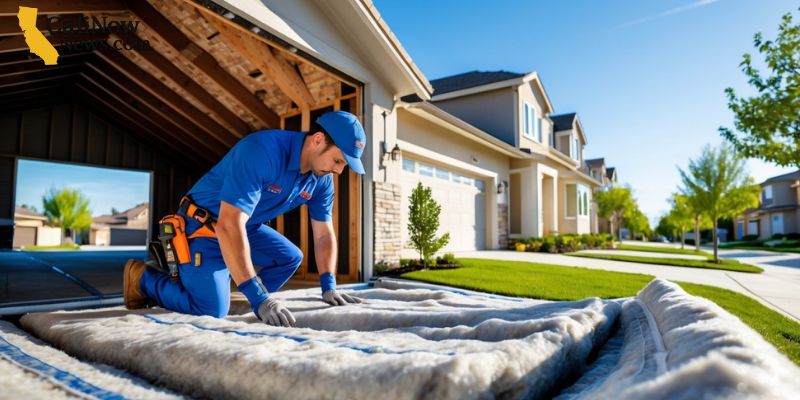Barrier Wall Insulation has introduced a new line of fire-resistant insulation in Chatsworth, offering advanced protection for homes and businesses. This new product is designed to slow the spread of flames and improve safety, especially in areas prone to fire risks.
The fire-resistant insulation combines trusted materials like fiberglass and specialized treatments to create a strong barrier against heat and flames. It also fits well in hard-to-reach spaces, providing better coverage and energy efficiency.
This launch marks a step forward in insulation technology for the local market, giving property owners more options to improve fire safety without sacrificing comfort.
Overview of Barrier Wall Insulation’s Fire-Resistant Line

Barrier Wall Insulation introduces a new line designed to improve fire protection in buildings. The product combines advanced fire-resistant materials with high thermal insulation. This line meets strict safety standards, aiming to deliver effective fire barriers in construction.
Product Features and Innovations
The new insulation line uses non-combustible materials that resist ignition and slow flame spread. It integrates fireproof components that maintain stability under high heat. The design supports easy installation, fitting various wall types including fire barriers.
Key features include:
- High thermal resistance to prevent heat transfer
- Compliance with ASTM E 119 fire resistance testing
- Suitable for use in fire partitions and fire walls
- Durable in both residential and commercial settings
The product innovates by balancing fire safety with good insulating performance, reducing energy loss without compromising protection.
Fire Resistance and Safety Benefits
The insulation line is engineered to enhance fire safety by creating reliable fire barriers. It withstands temperatures that could cause other materials to fail, helping to prevent fire spread.
Its fire resistance meets or exceeds important building codes. Testing shows it keeps flames and hot gases from passing through barriers, protecting adjacent areas.
Benefits include:
- Maintaining structural integrity during fire exposure
- Providing a flame-resistant shield that supports building safety
- Minimizing smoke and heat transfer to delay fire growth
This increases occupant safety and property protection, supporting fire safety standards in construction.
Launch Details in Chatsworth
The new insulation line officially launched in Chatsworth with a focus on local and regional builders. Barrier Wall Insulation held events to showcase product capabilities, including live demonstrations of fire resistance.
Distribution is set up through key suppliers in the Chatsworth area, ensuring easy access for contractors. Training sessions are also available to educate installers on best practices for maximizing fire protection.
The company targets both new construction and retrofit projects in commercial and residential buildings within Chatsworth. This launch supports the community’s growing demand for higher fire safety standards.
Technical Specifications and Performance

Barrier Wall’s fire-resistant insulation line uses advanced materials designed for strong thermal efficiency, sound control, and fire safety. The products balance different compositions to meet building codes and deliver reliable performance under heat and sound stress.
Insulation Materials and Composition
The insulation line includes mineral wool, fiberglass, and spray foam insulation. Mineral wool, made from rockwool or silica fibers, offers excellent fire resistance because it is non-combustible. Fiberglass provides good thermal insulation and sound absorption but has lower fire resistance compared to mineral wool. Spray foam insulation enhances thermal efficiency and offers air sealing but may need additives to improve fire resistance.
Some products use ceramic fibers for high-temperature resistance, especially in commercial applications. The materials are designed to optimize R-values for thermal insulation, meaning they effectively slow heat transfer. The line also includes foam insulation variants treated to meet fire safety standards, balancing energy savings with fire protection.
Thermal and Acoustic Performance
Thermal performance focuses on the insulation’s R-value, indicating how well it resists heat flow. Mineral wool and fiberglass batts achieve R-values suitable for residential and light commercial use. Spray foam insulation tends to offer higher R-values per inch, improving energy efficiency.
For sound control, mineral wool excels due to its dense fiber structure, reducing noise transmission in walls. Fiberglass also provides sound absorption but is generally less effective at blocking sound than mineral wool. The products support sound absorption and sound control standards, helping create quieter indoor environments.
Thermal efficiency is maintained even in fire-rated assemblies, ensuring buildings stay insulated during normal use and emergencies. The combination of materials strikes a balance between thermal insulation and sound absorption without compromising fire safety.
Fire Resistance Ratings and Code Compliance
The insulation line meets key fire rating requirements, including ASTM and UL classifications. Mineral wool and ceramic fiber products are inherently non-combustible and can achieve up to a two-hour fire resistance rating in wall assemblies. Fiberglass products are fire-resistant but may require additional layers or coatings to meet high fire standards.
Spray foam insulation included in the line is treated with fire retardants and tested to meet building codes for combustibility and flame spread. Many products comply with military and ICC standards, ensuring they work in fire-rated wall assemblies.
The line supports compliance with local and national fire codes, including ASTM E84 and UL fire tests. This allows builders to use these materials where fire safety is critical, such as in multi-family housing and commercial buildings.
Applications and Building Integration
Barrier Wall Insulation’s fire-resistant products serve multiple roles in building safety and comfort. Their design supports energy efficiency and limits fire spread while fitting into different building parts. Proper integration affects indoor temperatures, soundproofing, and the overall durability of structures.
Residential and Commercial Uses
The fire-resistant insulation is effective in both homes and commercial buildings. It helps maintain stable indoor temperatures, reducing reliance on heating and cooling systems and contributing to energy savings.
It also improves soundproofing, creating quieter environments in busy or crowded places. The insulation’s fire-resistant nature enhances safety for occupants by slowing fire spread and supporting compartmentation.
This insulation meets key standards for R-30 energy performance, making it suitable for modern energy codes. It is easy to install in walls and ceilings without affecting space or design.
Wall Assemblies and Ceiling Installations
The insulation integrates well into various wall assemblies and ceiling systems. It works with fire stops and barriers that prevent the fire from moving quickly through gaps or cavities.
Mineral wool or similar materials are often combined with this insulation for better fire resistance. This approach keeps the building’s structural integrity intact during a fire event.
In ceilings, it acts as a fire-resistant layer that also supports soundproofing and thermal comfort. The insulation fits tightly to reduce air leaks, which is important for both fire safety and energy efficiency.
Performance in High-Rise Buildings
In high-rise buildings, fire spread between floors is a major concern. This insulation plays a key role in floor assemblies, helping contain fire vertically between stories.
Its integration supports compartmentation, limiting fire to smaller sections of the building. This containment protects not only the occupants but also the building structure.
The product is designed to work alongside other fire-stopping materials and systems required in tall buildings. Its use supports compliance with strict fire codes for high-rise construction while maintaining energy and acoustic performance.
- Barrier Wall Insulation
- 9725 Owensmouth Ave, Chatsworth, CA 91311, United States
- +18188730701
- https://bestpriceinsulation.com/
Frequently Asked Questions
The new fire-resistant insulation line in Chatsworth offers specific safety features and meets strict fire standards. It improves protection around heat sources like fireplaces and wood stoves. Options include different materials and spray applications to fit various home needs.
What are the key features of the new fire-resistant insulation line offered in Chatsworth?
The insulation can resist high temperatures and slows the spread of flames. It meets fire safety tests such as ASTM E84 and is often paired with a fire barrier like drywall. This line is made to reduce fire risks in residential buildings.
How does fireproof insulation board compare to traditional insulation materials in terms of safety?
Fireproof insulation boards are designed to withstand higher temperatures without breaking down. Traditional materials, like fiberglass, can resist fire to a point but may degrade above 500°F. Fireproof boards help limit fire spread longer than standard options.
Can fire-resistant insulation enhance the safety of my home’s fireplace area?
Yes. Fire-resistant insulation helps protect walls and structures near fireplaces by resisting heat and flames. It should be installed with approved fire barriers like drywall to meet building codes.
What options are available for fireproof insulation for wood stoves?
Options include specially treated insulation materials and fire-resistant spray foam. Both types are designed to handle the heat around wood stoves and must usually be covered with a thermal or structural barrier.
Where can I find professional fireproof insulation services near me?
Local contractors specializing in insulation and fire safety can provide installation. Look for companies certified in fire-resistant materials and familiar with local building codes.
What are the benefits of using fireproof insulation spray over standard insulation methods?
Fireproof spray insulation can fill gaps and hard-to-reach spaces more effectively. It often provides better air sealing and can be combined with fire retardants. However, it typically requires a fire barrier like drywall for code compliance.




